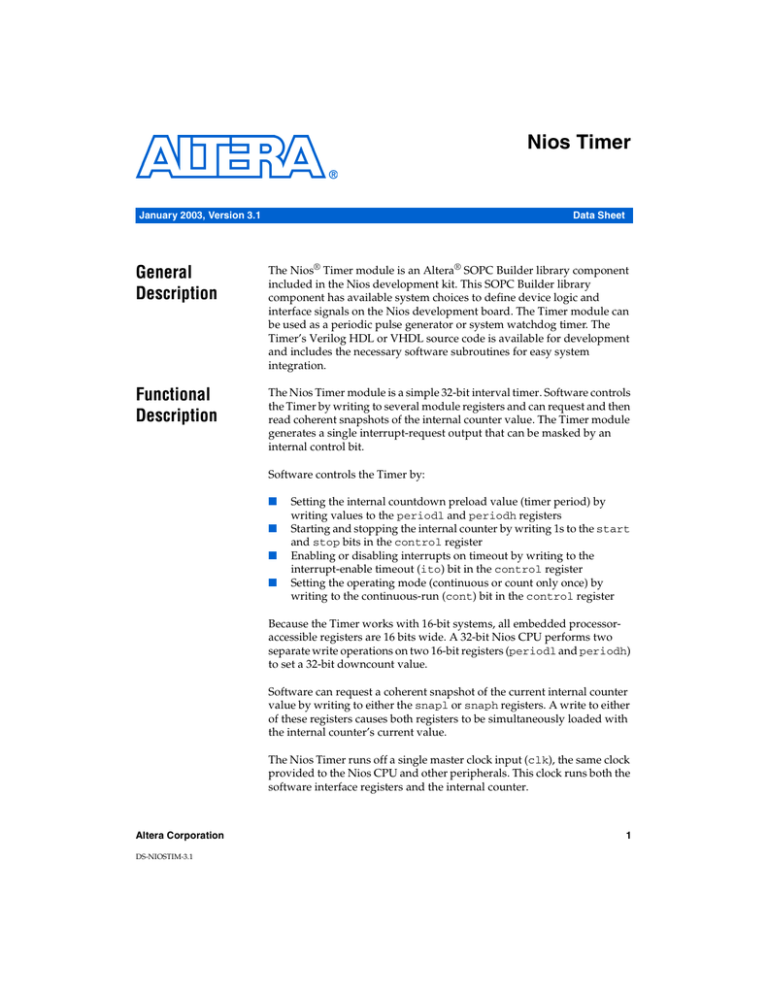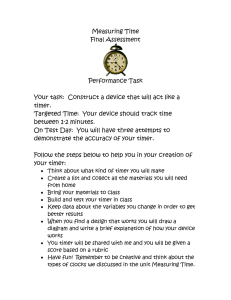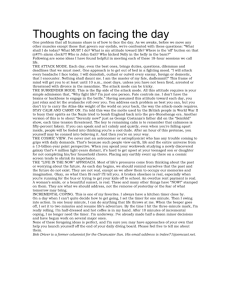
Nios Timer
January 2003, Version 3.1
Data Sheet
General
Description
The Nios® Timer module is an Altera® SOPC Builder library component
included in the Nios development kit. This SOPC Builder library
component has available system choices to define device logic and
interface signals on the Nios development board. The Timer module can
be used as a periodic pulse generator or system watchdog timer. The
Timer’s Verilog HDL or VHDL source code is available for development
and includes the necessary software subroutines for easy system
integration.
Functional
Description
The Nios Timer module is a simple 32-bit interval timer. Software controls
the Timer by writing to several module registers and can request and then
read coherent snapshots of the internal counter value. The Timer module
generates a single interrupt-request output that can be masked by an
internal control bit.
Software controls the Timer by:
■
■
■
■
Setting the internal countdown preload value (timer period) by
writing values to the periodl and periodh registers
Starting and stopping the internal counter by writing 1s to the start
and stop bits in the control register
Enabling or disabling interrupts on timeout by writing to the
interrupt-enable timeout (ito) bit in the control register
Setting the operating mode (continuous or count only once) by
writing to the continuous-run (cont) bit in the control register
Because the Timer works with 16-bit systems, all embedded processoraccessible registers are 16 bits wide. A 32-bit Nios CPU performs two
separate write operations on two 16-bit registers (periodl and periodh)
to set a 32-bit downcount value.
Software can request a coherent snapshot of the current internal counter
value by writing to either the snapl or snaph registers. A write to either
of these registers causes both registers to be simultaneously loaded with
the internal counter’s current value.
The Nios Timer runs off a single master clock input (clk), the same clock
provided to the Nios CPU and other peripherals. This clock runs both the
software interface registers and the internal counter.
Altera Corporation
DS-NIOSTIM-3.1
1
Nios Timer Data Sheet
The Timer may optionally be configured as a system watchdog. A
watchdog Timer produces a reset_output signal that is automatically
recognized by the SOPC Builder and used as an input to the system’s reset
logic.Table 1 lists and describes the Timer register map.
Timer
Registers
Table 1. Timer Register Map
A2..A0
Register
Name
R/W
0
status
RW
1
control
RW
2
periodl
RW
Timeout Period – 1 (bits 15..0)
3
periodh
RW
Timeout Period – 1 (bits 31..16)
4
snapl(1)
RW
Timeout Counter Snapshot (bits 15..0)
5
(1)
RW
Timeout Counter Snapshot (bits 31..16)
snaph
Description/Register Bits
15
...
3
2
1
0
run
to
stop
start
cont
ito
Notes
(1)
A write operation to either the snapl or snaph registers updates both registers with a coherent snapshot of the
current internal counter value.
status Register
Table 2. status Register Bits
Bit Number
Bit Name
0
to
Timer timed out
Description
1
run
Timer is running
to Bit
The to bit is set to 1 when the internal counter reaches zero. Once set by a
timeout event, the to bit stays set until explicitly cleared by software.
Software clears the to bit by performing a write operation to the status
register.
2
Altera Corporation
Nios Timer Data Sheet
run Bit
The run bit is set to 1 when the internal counter is running; otherwise this
bit is 0. Software starts and stops the internal counter by writing to the
stop and start bits in the control register.
The run bit is not changed by a write operation to the status register.
control Register
Table 3. control Register Bits
Bit Number
Bit Name
0
ito
Description
1
cont
Continuous mode
2
start
Start Timer
3
stop
Stop Timer
Enable interrupt for a timeout
ito Bit
If the ito bit is 1, the Timer generates an interrupt request (sets its IRQ
output to 1) when the status register’s to bit is 1. If the ito bit is 0, the
IRQ output is always 0.
cont Bit
The cont (continuous) bit determines how the internal counter behaves
when it reaches zero. When the internal counter reaches zero, it reloads
with the 32-bit value stored in the periodl and periodh registers,
regardless of the cont bit. If the cont bit is 1, the internal counter runs
until it is stopped by the stop bit. If cont is 0, the internal counter stops
after it reaches zero and reloads with the period value.
start Bit
Software starts the internal counter running (counting down) by writing
a 1 to the start bit. The start bit is an event bit—the counter is started
when the write operation is performed. The value stored in the start bit
has no subsequent effect on the internal counter. Writing a 0 to the start
bit has no effect on the Timer’s operation.
Altera Corporation
3
Nios Timer Data Sheet
Any 1 written to the start bit starts the counter, regardless of the stored
value. If the Timer is stopped, writing a 1 to the start bit causes the
Timer to restart counting from the number currently held in its counter.
Software may read back the start bit’s value.
stop Bit
Software stops the internal counter by writing a 1 to the stop bit. The
stop bit is an event bit that causes the counter to stop when a write
operation is performed. The value stored in the stop bit has no subsequent
effect on the internal counter. Writing a 0 to the stop bit has no effect on
the Timer’s operation. Software may read back the stop bit’s value.
1
When the PTF parameter always_run is set to 1, writing to the
stop bit has no effect on the internal counter.
periodl Register
The periodl register holds the 16 LSBs of the 32-bit down count preload
value (the 16 MSBs are held in the periodh register). The Timer’s actual
period (that is, interrupt rate) is one greater than the value stored in the
periodh and periodl register because the internal counter assumes the
value zero (0x00000000) for one clock cycle.
The internal counter is loaded with the 32-bit value stored in periodh
and periodl when one of the following occurs:
■
■
Software performs a write operation to either the periodh or
periodl registers
The internal counter reaches 0
The internal counter is automatically stopped when software writes to
either the periodh or periodl registers.
1
When the PTF parameter fixed_period is set to 1, a write
operation to the periodl register restarts the internal counter at
its initial (fixed) value.
When the PTF parameter always_run is set to 1, a write
operation to the periodl register does not stop the internal
counter.
4
Altera Corporation
Nios Timer Data Sheet
periodh Register
The periodh register holds the 16 MSBs of the 32-bit downcount preload
value (the 16 LSBs are held in the periodl register). The Timer’s actual
period (that is, interrupt rate) is one greater than the value stored in the
periodh and periodl registers because the internal counter assumes
the value zero (0x00000000) for one clock cycle.
1
When the PTF parameter fixed_period is set to 1, a write
operation to the periodh register restarts the internal counter at
its initial (fixed) value.
When the PTF parameter always_run is set to 1, a write
operation to the periodh register does not stop the internal
counter.
snapl Register
The snapl register holds the 16 LSBs of the most recently sampled 32-bit
counter snapshot (the 16 MSBs are held in the snaph register). Software
may request a coherent snapshot of the current 32-bit internal counter by
performing a write operation (write-data ignored) to either the snapl or
snaph registers. Software may request a snapshot whether or not the
internal counter is running. Requesting a snapshot does not change the
internal counter’s operation.
snaph Register
The snaph register holds the 16 MSBs of the most recently sampled 32-bit
counter snapshot. The 16 LSBs are held in the snapl register.
Watchdog Timer Operation
The Timer is configured as a system watchdog by these PTF assignments:
reset_output = "1";
always_run = "1";
fixed_period = "1";
A watchdog timer “wakes up” (comes out of reset) stopped. Software can
start the Timer at any time by writing a 1 to the control register’s start
bit. Once started, the Timer can never be stopped. The Timer generates a
pulse on its reset_out output when the internal count reaches zero.
Altera Corporation
5
Nios Timer Data Sheet
If the Timer is used as a module in an SOPC Builder system, the system
resets. Software can restart the internal counter at its initial value by
performing a write operation to either the periodl or periodh registers
(any data value written to these registers is ignored). Software must
continuously restart the watchdog timer (continuously write one or both
of the periodh/periodl registers) to prevent the system from being
reset.
For an example, see the file ../sdk/src/hello_watchdog.c.
Software Data
Structure
typedef volatile struct
{
int np_timerstatus;
int np_timercontrol;
int np_timerperiodl;
int np_timerperiodh;
int np_timersnapl;
int np_timersnaph;
} np_timer;
//
//
//
//
//
//
read only, 2 bits (any write to clear TO)
write/readable, 4 bits
write/readable, 16 bits
write/readable, 16 bits
read only, 16 bits
read only, 16 bits
Figure 1 shows an example of direct access to the Timer.
Example 1. Direct Access to Timer
#include "nios.h"
int main(void)
{
int t = 0;
// Set timer for 1 second
na_timer1->np_timerperiodl = (short)(nasys_clock_freq & 0x0000ffff);
na_timer1->np_timerperiodh = (short)((nasys_clock_freq >> 16) & 0x0000ffff);
// Set timer running, looping, no interrupts
na_timer1->np_timercontrol = np_timercontrol_start_mask + np_timercontrol_cont_mask;
// Poll timer forever, print once per second
while(1)
{
if(na_timer1->np_timerstatus & np_timerstatus_to_mask)
{
printf("A second passed! (%d)\n",t++);
// Clear the to (timeout) bit
na_timer1->np_timerstatus = 0; // (any value)
}
}
}
Software
Subroutine
6
The software subroutine nr_timer_milliseconds is available in the
Nios library (lib folder in the custom SDK) if one or more Timer
peripherals are present in the Nios system. This function is declared in the
include file nios.h.
Altera Corporation
Nios Timer Data Sheet
nr_timer_milliseconds
This subroutine requires the existence of a Timer called timer1, with a
base address defined by na_timer1 and an interrupt number defined by
na_timer1_irq. The first time this subroutine is called, it installs an
interrupt service subroutine for the Timer and returns zero. For each
subsequent call, the number of milliseconds elapsed since the first call is
returned.
Syntax
int nr_timer_milliseconds(void);
PTF
Assignments
Table 4 lists the Timer’s PTF parameters. Detailed descriptions follow the
table.
Table 4. Timer PTF Parameters
Parameter
Section1
Type
Allowed values
Default
clock_freq
S/WSA
Integer
x ≥ 1 (Hz)
33333000
fixed_period
M/WSA
Boolean
1, 0
0
snapshot
M/WSA
Boolean
1, 0
1
always_run
M/WSA
Boolean
1, 0
0
timeout_pulse_output
M/WSA
Boolean
1, 0
0
reset_output
M/WSA
Boolean
1, 0
0
period
M/WSA
String
>0
0
period_units
M/WSA
String
“ns”, “us”, “ms”, “s”,
“sec”, “clocks”
“sec”
mult2
M/WSA
Decimal
>0
.001
Note
(1)
(2)
Altera Corporation
The Section column describes the parameter’s location in the PTF:
S/WSA = SYSTEM/WIZARD_SCRIPT_ARGUMENTS
M/WSA = MODULE/WIZARD_SCRIPT_ARGUMENTS
The mult parameter is strictly a MegaWizard setting; resetting this value in the PTF
has no effect on system generation.
7
Nios Timer Data Sheet
clock_freq
The clock_freq assignment is the global system clock frequency. It
affects the generation of the Timer’s achieved period. This setting is
derived from the system PTF, and is not set by SOPC Builder.
fixed_period
When fixed_period is set to 1, the periodl and periodh registers
cannot be written to in the Timer. In this case, the periodl and periodh
registers’ contents are determined by the period and period_units
parameters. When fixed_period is set to 0, the periodl and periodh
registers are writable and any downcount can be set.
snapshot
When snapshot is set to 0, the snapl and snaph registers do not exist.
In this case, reading from the snapl and snaph registers produces an
undefined result.
always_run
When always_run is set to 1, the control register’s start and stop
bits do not exist—the internal counter runs continuously. When
reset_output is set to 1, the control registers’ start bit does exist
and the Timer can be started but not stopped (for watchdog timer
functionality).
timeout_pulse_output
When timeout_pulse_output is set to 1, a system output port,
timeout_pulse, is generated. This port pulses high for every instance of
a timeout. This output pulses true for exactly one clock when the Timer
reaches 0.
reset_output
When reset_output is set to 1, an output port, resetrequest, is
generated. This port pulses high for every instance of a timeout.
resetrequest pulses true for exactly one clock when the Timer reaches
0.
When reset_output is set to 1, the internal counter is stopped at reset.
It starts when the control register’s start bit is set to 1.
8
Altera Corporation
Nios Timer Data Sheet
period
When the fixed_period parameter is set to 1, the period assignment,
along with the period_units and clock_freq assignments, specifies
the downcount value in the periodl and periodh registers, according
to the formula:
scale = if (period_units = "s" or "sec") then 1
else if (period_units = "ns")
then 1E-9
else if (period_units = "us")
then 1E-6
else if (period_units = "ms")
then 1E-3
if (period_units = "clocks") then
Down-Count = period - 1
else
Down-Count = period * scale * clock_freq;
period_units
The period_units assignment specifies the unit of measure to be used
for the period assignment. The allowed values are shown in Table 5:
Table 5. period_units Allowed Values
Value
Description
ns
nanoseconds
us
microseconds
ms
milliseconds
s
seconds
sec
clock
1
use the assigned clock frequency
The default value is “sec”.
mult
The mult assignment is strictly an SOPC Builder setting used by the
MegaWizard. Changing the value of mult in the PTF has no effect on the
system generation.
Altera Corporation
9
Nios Timer Data Sheet
101 Innovation Drive
San Jose, CA 95134
(408) 544-7000
http://www.altera.com
Applications Hotline:
(800) 800-EPLD
Literature Services:
lit_req@altera.com
10
Copyright © 2003 Altera Corporation. All rights reserved. Altera, The Programmable Solutions Company, the
stylized Altera logo, specific device designations, and all other words and logos that are identified as
trademarks and/or service marks are, unless noted otherwise, the trademarks and service marks of Altera
Corporation in the U.S. and other countries. All other product or service names are the property of their
respective holders. Altera products are protected under numerous U.S. and foreign patents and pending
applications, mask work rights, and copyrights. Altera warrants performance of its
semiconductor products to current specifications in accordance with Altera’s standard
warranty, but reserves the right to make changes to any products and services at any time
without notice. Altera assumes no responsibility or liability arising out of the application
or use of any information, product, or service described herein except as expressly agreed
to in writing by Altera Corporation. Altera customers are advised to obtain the latest
version of device specifications before relying on any published information and before
placing orders for products or services.
Altera Corporation






